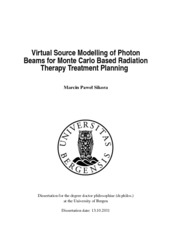| dc.contributor.author | Sikora, Marcin Pawel | en_US |
| dc.date.accessioned | 2011-10-24T14:06:44Z | |
| dc.date.available | 2011-10-24T14:06:44Z | |
| dc.date.issued | 2011-10-13 | eng |
| dc.identifier.isbn | 978-82-308-1845-9 (print version) | en_US |
| dc.identifier.uri | https://hdl.handle.net/1956/5135 | |
| dc.description.abstract | Modern radiotherapy (RT) techniques such as stereotactic body radiotherapy (SBRT), intensitymodulated radiotherapy (IMRT) or volumetric modulated arc therapy (VMAT) carries the potential of improving the quality of treatment. However, they often lead to complex beam arrangements where the effects of electron transport can only be handled by Monte Carlo (MC) dose calculation algorithms. The biggest obstacle for use of MC in RT is an accurate and efficient beam model which is able to model clinical beams with all the imports of a broad radiation field which is specific to each treatment machine. We have applied the concept of virtual source modelling to develop such a beam model based on the following ideas: • identification of the nature of beam components by a full MC simulation of the accelerator head, • identification of models and reference parameters which are universal, • definition of a few open parameters that need to be tuned by reliable measurements, • development of a robust commissioning method by poly-energetic kernels, • performing simultaneous validation of the beam model during commissioning. The resulting Virtual Source Model (VSM) employs three sources representing three distinguishable beam components: primary photons, secondary photons and electron contamination. Each source is described by analytical functions with two types of parameters (1) reference parameters fixed based on the full MC data analysis and (2) open parameters which are fitted during commissioning of the model for each individual accelerator. The sources reproduce a variety of effects which are present in broad clinical beams by employing the following corrections: • off-axis energy softening for primary and secondary photons, • absorption/scatter in the flattening filter, • energy fluence normalisation, • energy fluence flatness and particle fluence central depression for primary photons, • correction for energy-focussing of the source distribution for secondary photons and contamination electrons, • enhancement of the focus spot particle fluence for contamination electrons. The developed model was commissioned and validated for clinical use for 6 MV and 15 MV beams of two types of Elekta linacs equipped with a standard leaf-width MLC (leaf width 1 cm@isocentrum) and a mini-MLC (leaf width 4 mm@isocentrum). Several tests were performed for various beam arrangements. The MC dose calculation with the VSM shows excellent agreement with measurements in water and in a heterogeneous lung phantom, both for rectangular fields from 0.8x0.8 cm² to 40x40 cm² as well as for complex IMRT fields. For complex IMRT beams measured in water, the agreement was within 3%/2 mm inside the field and 5%/2 mm outside the field (tails of cross profiles) for 6 MV and 15 MV beam, respectively. While 3%/3 mm agreement was achieved between MC calculated dose and film measurements in the lung phantom. In conclusion, a VSM for a clinical broad photon beam was developed which is accurate and efficient. The VSM model overcomes problems related to full MC simulation of the accelerator head like long simulation time, cumbersome commissioning routine and dependency on the technical information about the accelerator head. This VSM enables a broad implementation of MC-TPS in clinical routine. | en_US |
| dc.language.iso | eng | eng |
| dc.publisher | The University of Bergen | eng |
| dc.relation.haspart | Paper 1: M. Sikora, O. Dohm and M. Alber: A virtual photon source model of an Elekta linear accelerator with integrated mini MLC for Monte Carlo based IMRT dose calculation. Physics in Medicine and Biology 52(15), 4449–63, August 2007. Full text not available in BORA due to publisher restrictions. The article is available at: <a href="http://dx.doi.org/10.1088/0031-9155/52/15/006" target="_blank"> http://dx.doi.org/10.1088/0031-9155/52/15/006</a> | en_US |
| dc.relation.haspart | Paper 2: M. Sikora and M. Alber: A virtual source model of electron contamination of a therapeutic photon beam. Physics in Medicine and Biology 54(24), 7329–44, December 2009. Full text not available in BORA due to publisher restrictions. The article is available at: <a href="http://dx.doi.org/10.1088/0031-9155/54/24/006" target="_blank">http://dx.doi.org/10.1088/0031-9155/54/24/006</a> | en_US |
| dc.relation.haspart | Paper 3: M. Sikora, J. Muzik, M. Söhn, M. Weinmann and M. Alber: Monte Carlo vs. pencil beam based optimization of stereotactic lung IMRT. Radiation Oncology 4, 64, 2009. The article is available at: <a href="http://hdl.handle.net/1956/5134" target="_blank">http://hdl.handle.net/1956/5134</a> | en_US |
| dc.title | Virtual Source Modelling of Photon Beams for Monte Carlo Based Radiation Therapy Treatment Planning | en_US |
| dc.type | Doctoral thesis | |
| dc.rights.holder | Copyright the author. All rights reserved | |
| dc.subject.nsi | VDP::Medical disciplines: 700::Clinical medical disciplines: 750::Oncology: 762 | eng |
